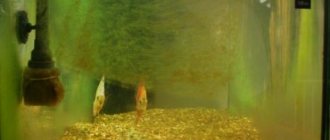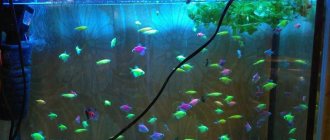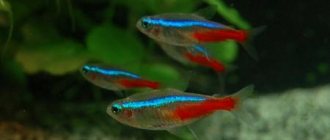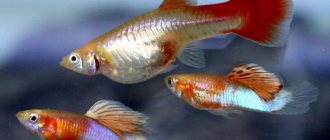Changing the water is an important part of maintaining a healthy and balanced aquarium. We will try to explain in detail why to do this and how often in our article. There are many opinions about changing water: books, Internet portals, fish sellers and even your friends will give different numbers for the frequency and amount of water changes.
It is impossible to name the only correct solution; it all depends on many different factors that need to be taken into account.
In order to choose the ideal option specifically for your aquarium, you need to understand why we replace exactly this amount of water, and not more or less. A mistake can lead to disaster, both if we replace too much and if we replace too little.
Reducing nitrate levels in water
If you do not regularly change the water in the aquarium, the level of nitrates (they are formed as breakdown products in the process of life) will gradually increase. If you don't check their quantity, you won't even notice it.
The fish in your aquarium will gradually become accustomed to the increased levels and will only become stressed if the amount of nitrates in the water is very high for a long time.
But any new fish will almost certainly become accustomed to a lower level, and when you place it in your tank, it will become stressed, get sick, and may die. In neglected aquariums, the death of new fish causes an even greater shift in the balance, and the old fish (weakened by the high nitrate content) becomes ill. A vicious circle leads to the death of fish and upsets the aquarist.
Sellers are aware of this problem, as they themselves are often blamed for fish deaths. From the aquarist's point of view, he bought new fish, put them in the aquarium (which was doing great), and soon all the new fish died, along with several old ones. Naturally, the sellers are blamed, although the reason must be looked for in your aquarium.
With regular water changes, nitrate levels decrease and remain low.
In this way, you significantly reduce the chance of disease in fish, both new and long-lived in your aquarium.
How often, after how many days is it necessary?
The intervals between water replacement procedures depend on the “age” of the ecosystem in the aquarium and a certain stage of its development. There are four of them:
New. Having started the ecosystem from scratch, for 3 months the aquarium (with and without a filter) does not need to be “disturbed” at all, allowing the microclimate to form without outside interference.- Young (3 months to a year). The water is changed once a month (without a filter) or once a month and a half (with a filter) in a volume of maximum 20-25%. If everything is in order with its quality, it is limited to 10%.
- Mature (from one to two years). Water is changed in the same volume, but twice as often. When the fauna and flora feel good, you can “extend” replacing it for another 7-10 days.
- Old (2 or more years). For two months, water (25-30%) is changed every 2 or 3 weeks (with and without a filter, respectively), combining this with thorough cleaning and rinsing of the soil. Then, for 8-10 months, they return to the care regime for a mature aquarium.
The water needs to be changed more often (every 7-10 days) if fish are being treated - the concentration of the drug in the water gradually increases, and it turns into poison.
Changing the water stabilizes the pH
The second problem with old water is the loss of minerals in the aquarium. Minerals help stabilize the pH of water, that is, keep its acidity/alkalinity at the same level.
Without going into details, it works like this: acids are constantly produced in the aquarium, which are decomposed by minerals and the pH level remains stable. If the level of minerals is low, the acidity of the water constantly increases.
If the acidity of the water increases to the limit, it can cause the death of all life in the aquarium. Changing the water regularly introduces new minerals into the old water and the pH level remains stable.
What will happen without replacement?
The question arises: can an aquarium function without changing the water? Of course it can. But only if there is complete biological and chemical filtration of aquarium water, which helps maintain the concentration of unsafe toxins and chemical combinations at a level that is not dangerous for the aquarium.
Both types of filtration are supported by external filters, which are quite expensive, but guarantee optimal quality of water purification.
Important! Such maintenance will not lead to any problems with the aquarium. However, the presence of fish and plants will be bleak and the aquarium will look rather dull.
If you change too much water
Now that it is clear that changing water is important, you need to understand that too much, as well as too little water changes, is bad. Although in general a water change is necessary, it must be done carefully, since any sudden changes in the closed world of the aquarium harm it.
Changing too much water at once can be harmful. Why? When 50% or more of the water is changed to new water, this significantly shifts the characteristics in the aquarium - hardness, pH, even temperature change significantly. As a result, there is a shock for the fish, the beneficial bacteria that live in the filter may die, and delicate plants will shed their leaves.
In addition, the quality of tap water leaves much to be desired, which is what is used in most cases. It contains increased levels of minerals, nitrates and chemicals for water purification (the same chlorine). All this has an extremely negative impact on the inhabitants of the aquarium.
By replacing the water only partially (no more than 30% at a time), and not half at once, you are making only small changes to the established balance. Harmful substances are supplied in limited quantities and are utilized by bacteria. A large replacement, on the contrary, maintains a dangerous level and significantly upsets the balance.
Why do a full shift?
A complete change of water is rarely carried out, and there must be good reasons for this, but directly:
- progressive water bloom, provoked by a violent increase in green algae;
- the appearance of fungal mucus on the walls of the aquarium and decorative components;
- severe clogging and souring of the bottom substrate;
- infectious diseases of fish or plants caused by the introduction of infections into the aquatic system.
A complete change of water has a negative effect on aquarium animals. After all, in new water it enters the environment of an unformed ecosystem. In addition, even despite the preparation of new water, its characteristics will still differ from usual ones.
You need to realize that such a change leads to stress for ornamental fish, and even to their death. Vegetation also responds to new conditions: plant leaves may turn white after moving to new water.
In this way, a complete change is a restart of the aquarium, when the formation of the ecosystem begins again.
This should be resorted to only in extreme cases and should be done with proper cleaning.
Fresh water
Tap water usually needs to be settled to remove chlorine and chloramine from it. It is better to stand for 2 days. The quality of water varies in different regions, but it is better to assume that the water in yours is of low quality. God protects those who are careful, so try to change the water to tap water regularly and in small quantities, or buy a good filter to clean it.
Also, in different regions, the hardness of water can differ significantly; for example, in neighboring cities there can be both very hard and very soft water.
Measure the parameters, or talk to experienced aquarists. For example, if the water is very soft, you may need to add mineral additives to it.
And if you use water after purification by reverse osmosis, they are simply necessary. Osmosis removes everything from water, even minerals.
Necessary equipment
Many aquarists assume that changing the water in the tank takes a lot of time. Carrying out this process does not take much effort. It is only important to have the necessary knowledge and allocate a little time for the procedure. To maintain the tank, you will need to purchase some tools.
Before you begin, you need to determine the type of aquarium. Tanks with a volume of no more than two hundred liters are considered small, while other containers are large. To change water in small tanks, you will need the following list of tools:
- Bucket, volume 10–12 liters.
- Rubber hose, 1.5 meters long.
- Ball valve.
- Siphon with pear.
BASIC ACTIONS FOR AQUARIUM CARE
It is very important to keep the aquarium clean
. Dirty water can cause illness and even death of your pet.
Daily aquarium care
Daily care of the aquarium includes the following activities : - feeding the fish;
Feed the fish
1-2 times a day
.
You need to give as much food as the fish eats in a minute or two
, so that the remaining food does not fall to the bottom. Overfeeding has a bad effect on both the health of the fish and the quality of the water. The less uneaten food remains, the less dirt and a more stable aquarium.
-
removing food debris from the bottom;
Each time after feeding, you must immediately remove all remnants of uneaten food from the bottom. In a small aquarium, this can be done using a small hose with a bulb at the end or a regular tube (straw). To do this, we clamp the tube on one side with our finger, lower the other end to the bottom in the place where there is dirt, release the finger and the dirt, along with a small amount of water, ends up in the tube, then we clamp the tube with our finger again, take it out and pour it into a previously prepared container.
— monitoring the health of the fish;
Examine the fish every day to make sure it is healthy: changes in color, the appearance of spots, tubercles, ulcers, sticking of fins, mucous discharge, clouding of the eyes, swelling of the contour around the eye, non-adherent scales, asymmetry of the abdomen, etc.
Also observe the behavior of the fish: has it lost interest in what is happening around it, has it changed its usual behavior, has it lost its appetite, etc.
If a sick fish is discovered, it is better to immediately remove it from the general aquarium for quarantine.
— the presence of visible contaminants in the aquarium: a bacterial layer on the surface of the water, plaque on the internal walls and decorative elements, turbidity in the water and others;
If contamination is detected, you need to start unscheduled cleaning: the bacterial layer is removed with a sheet of paper, which is placed on the surface of the water and then removed; plaque is removed using a scraper, sponge or brush; the turbidity is removed by siphoning the soil and replacing part of the water, etc.
— checking the serviceability of aquarium equipment
.
If your small aquarium has any equipment ( filter, lamps, heating equipment, etc.
), then check their serviceability. In the event of a malfunction, unplug electrical appliances and remove them from the aquarium.
Scheduled regular cleaning of the aquarium
Make a schedule
) with a list of necessary measures for caring for the aquarium (
cleaning the aquarium and changing water
). With irregular care, the aquarium environment will be destabilized and the health of the fish will be at risk.
Let us note right away so that there is no confusion. There are two cleaning methods :
complete
and
partial
.
Complete cleaning of the aquarium –
complete water change and washing of the aquarium and all its contents (
soil, plants, decorations
).
Aquarists recommend carrying out such cleaning in a small aquarium no more than once
every
six months
, since it disrupts the entire established biosystem in the aquarium, and you will have to start the aquarium again. Many novice aquarists make the mistake of completely changing the water and washing out all its contents when cleaning the aquarium weekly.
The second method is regular cleaning of the aquarium.
with
partial water replacement
(
that is, draining part of the water and replacing it with fresh, settled water
). Today we will talk about her.
List of operations for weekly aquarium cleaning
Step 1. Cleaning the glass
We start
cleaning the aquarium with
the glass
.
Regardless of whether your aquarium is large or small, dirt, plaque in the form of organic matter and algae accumulate on its inner walls. The walls of a small aquarium are usually cleaned no more than once a week
.
You can remove plaque from glass using a scraper ( with a blade or a magnetic scraper
), sponge, clean rag or new toothbrush. If you use a scraper, carefully clean the glass in the corners of the aquarium so as not to accidentally cut the sealant. When using other available means (sponges, rags, brushes), keep in mind that they must be new, otherwise detergents may remain on them, which have a detrimental effect on the inhabitants of the aquarium.
You should not use soap when cleaning the aquarium. Can be washed without any detergent ( just water
) or special solutions for washing aquariums, which can be purchased at pet stores.
All algae ( green
) it is not necessary to catch the plaque that comes off the walls from the aquarium, but it is still better to remove most of it from the water.
Please note that the frequent and abundant appearance of green or brown deposits in the aquarium is a sign of poor water quality. The reasons may be
: pollution, overcrowding of the aquarium, high concentrations of ammonia, nitrites and nitrates, lack of regular water changes, etc. Carry out tests and eliminate the causes.
Step 2: Cleaning the decor
After the glass, they begin to decorate: inspect all decorative elements ( stones, artificial plants, jugs, locks, etc.
) and, if necessary, begin cleaning.
In a small aquarium, decorations are usually cleaned once every 1-2 weeks
, depending on the size of the aquarium and how dirty it is.
There are two options for cleaning decor. First option
– go over the decorations with a new sponge (
brush
) right in the aquarium, without taking them out.
The second option
is to clean all the decorations from the aquarium and wash them with clean water at room temperature.
If necessary ( for example, when cleaning algae deposits
), you can use a new sponge (
brush
) or a new toothbrush. The main thing when cleaning is not to use soap or other detergent. If it is very dirty, you can use baking soda, but then rinse the items thoroughly in clean water several times.
Step 3. Treatment of aquarium plants (if any)
Even small aquariums can have live vegetation, which not only reduces stress in fish, but also helps remove dangerous substances from the water ( nitrites, nitrates and ammonia
).
yellowed and rotten
from living plants using scissors. They also prune and weed overgrown plants. When weeding, it is important to try not to raise mud from the bottom. Plants are replanted if necessary.
After caring for plants, turbidity forms in the water, you need to wait a few minutes 5-10
until it settles to the bottom, then carefully remove the deposited plaque from the leaves with your fingers and proceed to the next step.
Step 4. Cleaning the bottom and soil (if any)
The next step is cleaning the bottom or siphoning the soil.
In a small aquarium, as in a large one, soil is often poured to the bottom. Particles of uneaten food and fish waste regularly settle on it, so the soil also needs to be cleaned regularly.
However, soil is not only decor, but also an important element of the aquarium ( colonies of aerobic bacteria live on the surface of the substrate, taking an active part in the nitrogen cycle of the aquarium
).
Constant stirring of the aquarium soil will disrupt the biological processing of organic waste, which occurs in the thickness of the substrate ( deterioration of bottom filtration
). This may also lead to an increase in the concentration of nitrites and ammonia.
Therefore, we would not recommend cleaning the soil weekly. It is necessary to clean the soil as it becomes contaminated. To understand when to clean the soil, stir it slightly. If there is cloudiness, a lot of bubbles or an unpleasant odor, then the soil must be cleaned. If few or no bubbles rise, then put the soil siphon aside.
Typically, when cleaning soil, a siphon is used ( a small cylindrical device with a rubber hose
). The tip is moved along the aquarium bottom, periodically sticking it into the ground. Sometimes they use a small hose with a bulb at the end.
When siphoning the soil, some of the water is drained along with dirt and fish waste; this must be taken into account when changing the water.
If there is no soil in the aquarium, then we simply clean the bottom of the aquarium. You need to remove all the dirt that has accumulated on the bottom of the aquarium.
Step 5. Water change
Then you should change the water in the aquarium to remove some of the harmful substances that have accumulated in it.
Replacing part of the water
- the most important point in caring for an aquarium.
In nano-aquariums, a large change of water introduces instability and imbalance, therefore, the smaller the aquarium, the more often the water needs to be changed, but in small parts. On average, water changes in a small aquarium should be carried out every 3-4 days
no more than 20-30%
at a time .
Usually recommended in 10-20 liter
in an aquarium, change
1/3 of the water once every 5-7 days
, and in
a 5-10 liter aquarium
-
1/5 every 2-3 days
.
Change more than 50%
water is only available in case of emergency. A complete replacement is fraught with disruption of biological balance and restarting the aquarium.
To change the water in the aquarium, you can use a siphon with a funnel, pumping out the required amount of water from the bottom. At the same time, monitor the volume of water drained. To avoid draining more than necessary, you can make a mark on the side wall of the aquarium.
Step 6: Clean the filter (if equipped)
Filter maintenance depends on the type of device ( mechanical, chemical or biological
).
Usually in small aquariums they install a simple internal filter - a pump with a fine-pored sponge inside. It is advisable to wipe the outer filter housing weekly to remove deposits. And the inner sponge of the filter is washed as needed, when the stream of water from the outlet weakens or the filter begins to work poorly. This usually happens once every 2 weeks
.
In this case, it is better to wash sponges or other filter materials in a basin with aquarium water ( in water pumped out from the aquarium
). It is not recommended to rinse the sponge under running tap water and use detergents, as the beneficial colony of anaerobic bacteria that has formed in the filter will be washed away. These bacteria are involved in maintaining biological balance in the aquarium. Bacteria settle on foam sponges and other fillers, carrying out biological filtration of water.
After the equipment has been washed and installed in place, fresh water can be added.
Step 7. Add fresh water to the aquarium
When all manipulations are completed, pour fresh, settled water
, which has the same temperature as the water in the aquarium. You should always have settled water ready, because in a small aquarium water changes occur more often than in a large one. If tap water is used for replacement, it should sit for several days.
You can pour water into a small aquarium using a hose, cup or jar.
Impact on inhabitants
Changing water is always stressful for fish and other inhabitants of the tank. It is necessary to carry out this operation at least once a week in order to accustom the animals to a temporary imbalance.
Neglecting such an important component as changing water can have a detrimental effect on the health of the fish. There have been cases where the inhabitants of the aquarium simply got used to the poisons and conditions. After some time, they experienced a decline in immunity. The fish became lethargic and inactive. Soon the day would come for an outbreak of fungal or bacterial diseases, during which the creatures would die. The decomposition of fish leads to excessive release of nitrogenous compounds, which provoke intensive growth of algae in the aquarium.
The reaction of plants to replacement directly depends on the substances contained in the liquid. It is important to consider the percentage of acidity and hardness. It is these indicators that affect the growth of algae.
After changing the water, the inhabitants of the tanks return to normal activities. Regularly performing this action will help maintain the concentration of substances at normal levels, as well as create a beautiful appearance for the aquarium.
Sequence of work
Even a partial water change is a whole set of measures that are carried out as needed. They have their own order, determined by the logic of different actions:
- Cleaning the filter . Produced first. This applies to a greater extent to internal filters, since external ones can be cleaned simply by temporarily shutting off the water flow system.
- Cleaning walls from plaque and fouling. This is done using special brushes and scrapers. Also, if necessary, you can clean grottoes and other objects from fouling.
- Working with plants . At this stage, the volume of overgrown green mass is reduced (if necessary), dead shoots are separated, and thinned out.
- Cleaning the soil with a siphon. Using a siphon purchased or made independently, part of the water is pumped out from the bottom area along with silt and organic residues. Sometimes during this operation the required 15–25% of water is lost.
- If this does not happen, water is sucked out from the middle or surface layers with a tube covered with a mesh.
- Add water using a pump or “the old fashioned way” - placing the container with settled water higher and pulling air from the free end. Make sure that the stream is not powerful and does not hit the fish.
Lifehack
If the container is small, it is not difficult to save 20 - 30 liters of water. But owners of aquariums of 200 - 300 liters have a hard time. In this case, when completely replacing, tap water is poured directly into the aquarium and waited for several days. Plastic containers in the form of horizontal and vertical barrels are well suited for periodic partial replacement. If the aqua is very large, it is worth purchasing a small submersible pump with a polymer hose.
Other methods of preparation are boiling and freezing, however, due to the labor-intensive nature of these processes for large quantities of water, they are rarely used.











